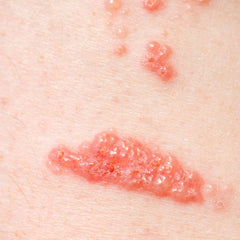Conquering Poison Ivy, Oak, and Sumac Rash!
By Dr. Peter Klapper Ph.D.
If you’re a nature enthusiast, you may be aware of the itchy price tag that can come from interacting with plants such as poison ivy, oak, and sumac. All three of these plants produce an oil, called urushiol, that can cause an allergic reaction in many people leading to a red, itchy rash. If this sounds like something you may have recently encountered, don’t worry. We have all the tips to help you conquer the itch and discomfort that comes from oak, sumac, and poison ivy rash.
How To Identify Toxic Plants
So, what does oak, sumac and poison ivy look like? Well, it’s important to be able to identify these itchy plants to avoid them in the future. You may be familiar with the popular phrase, “leaves of three, let it be.” Both poison ivy and oak typically have shiny, three leaflets per leaf and are found in the continental United States. Sumac doesn’t have the same warning as the “three leaves” but has rows of paired leaflets, with a single leaflet at the end and found in wet areas like swamps and peat bogs.
Now, if you suspect you've come into contact with these plants, you need to wash the affected area with soap and water immediately. Washing can help remove the urushiol oil before it has a chance to penetrate the skin and cause a reaction.
Identifying The Rash
If you recently went on a hike and now have a rash, it may be hard to know which plant you encountered as the rash can look similar with poison ivy, oak and sumac. However, there are ways to be able to identify the rashes by various characteristics.

Poison Ivy rashes typically appear as redness, swelling, and blisters and appear within 12-48 hours after exposure. The rash is extremely itchy and the appearance tends to materialize in a way mimicking how the plant brushed on the skin such as a streak-like pattern.
Poison Oak is very similar to poison ivy and appears as redness, swelling, and blisters but can take up to 72 hours after exposure. It is very itchy just like poison ivy and typically appears in a linear pattern.
Poison Sumac is slightly different than oak and poison ivy and may be more severe and involve larger areas of the skin. The rash typically takes anywhere from 12 to 72 hours to develop and will appear as red bumps or blister patches that often ooze. Again, the rash is very itchy and may be accompanied with swelling.
How To Treat Your Rash
So, you have a rash from these plants. What do you do? Luckily, there are oak, sumac, and poison ivy treatment options. First, you’ll want to make sure you don’t let it spread to other parts of your body. If you can, immediately rinse the exposed area with lukewarm water and mild soap. You will also want to wash your clothing, tools, pets, or anything else that encountered the plants. Lastly, these rashes can be extremely itchy, but you will need to try and not scratch to avoid infection.
Over the counter remedies can also help such as calamine lotions and hydrocortisone creams to reduce and soothe itching. Cool compresses are great for reducing inflammation and itching, along with oatmeal baths. And if you’re looking for a natural treatment, our Anti-Itch Extra Strength features a blend of super potent anti-inflammatory medicinal plants in both homeopathic and allopathic potencies which help stop uncomfortable itching and aggravation.
How To Prevent Contact with Poison Ivy, Oak, and Sumac
There are many misconceptions and myths surrounding these plants such as “I can only get it by touching the plant directly” or “I can’t get a rash in the winter.” However, if you encounter these plants or clothing/animals that have touched the plant, you’re still at risk for a poison ivy rash spreading. Poison ivy isn’t contagious, and it is preventable. So, how do you prevent contact while enjoying the outdoors?
First, be sure you’re able to recognize each plant so you can avoid them. You should also wear protective clothing such as long sleeves, pants, and gloves to create a barrier between your skin and the plants. If you do have exposed skin, consider using a barrier cream or lotion. Lastly, make sure to stay on designated trails to minimize risk of brushing against these plants.
Say you do encounter the plants, quickly wash any equipment or clothing with soap and water that may have touched the plant in order to avoid oils from touching your skin.
Understanding and identifying poison ivy, oak, and sumac is crucial for avoiding their itchy rashes. By being able to identify the plants and quickly react if exposed and prevent the spreading of oils, you can set yourself up for success in prevention and treatment while enjoying the great outdoors.




